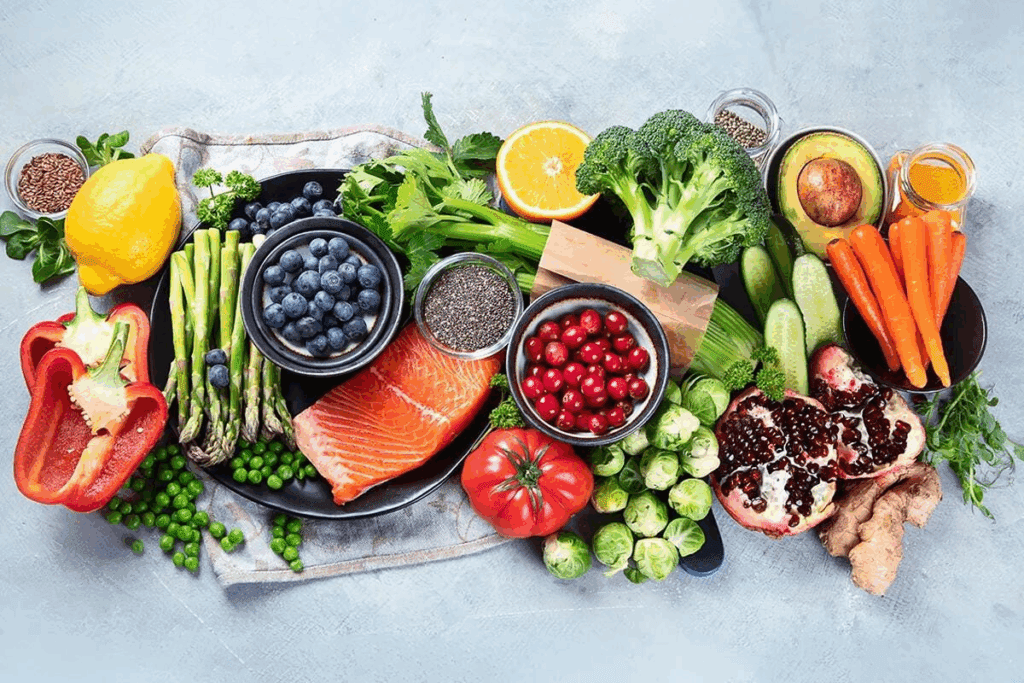Last Updated on November 26, 2025 by Bilal Hasdemir

After bariatric surgery, a good meal plan is key for recovery and keeping weight off. We know how hard it is to adjust to new eating habits after surgery. Our team is here to help you every step of the way.Build a successful gastric sleeve meal plan with these 7 essential rules. Includes printable PDFs to help you stay on track.
At Liv Hospital, we see how important a gastric sleeve meal plan is for your health and weight. We offer patient-centered help and reliable resources. You can find printable PDFs and high-protein menus to help you on your journey.

Patients need to understand how gastric sleeve surgery affects digestion and nutrition. This knowledge helps them make better choices about their diet after surgery. Gastric sleeve surgery, or sleeve gastrectomy, removes a big part of the stomach. This leaves a narrow “sleeve” or tube-like stomach.
Gastric sleeve surgery changes digestion a lot. It makes the stomach smaller, so you can’t eat as much. This helps with weight loss. It also changes how nutrients are absorbed, because the stomach is smaller and the body’s anatomy is different.
Key Changes in Digestion:
After surgery, patients need different nutrients. The diet starts with clear liquids, then moves to pureed foods, soft foods, and regular textured meals. This helps the stomach heal and lowers the risk of problems.
| Diet Stage | Food Texture | Duration |
| Phase 1 | Clear Liquids | First Week |
| Phase 2 | Pureed Foods | Weeks 2-3 |
| Phase 3 | Soft Foods | Weeks 4-5 |
| Phase 4 | Regular Textured Foods | Week 6 and Beyond |
Patients must follow this diet carefully to heal properly and avoid problems. They also need to pay attention to their nutrition to avoid missing out on important nutrients like protein, vitamins, and minerals.
Nutritional Focus Areas Post-Surgery:

A structured gastric sleeve meal plan is key for patients after surgery. It helps them deal with changes in their digestive system. This makes it vital to stick to a planned diet.
Starting a journey to weight loss and better health after surgery can seem tough. But with the right bariatric meal plans, patients can avoid problems. They can also get the best results from their weight loss.
Proper meal planning after gastric sleeve surgery has many benefits. These include:
We suggest using post-bariatric surgery meal plan PDF resources. They offer detailed advice on meal planning and nutrition after surgery.
Poor nutrition choices after gastric sleeve surgery can cause problems. These include:
Understanding the need for a structured gastric sleeve meal plan and the dangers of bad nutrition is important. Patients can then take steps to achieve successful weight loss and keep their health good after surgery.
A 3-month diet before bariatric surgery is key to lower risks and better results. It’s vital for those getting bariatric surgery. It helps shrink the liver and cuts down on surgery complications.
The diet has several main goals. First, it aims to shrink the liver size, making surgery safer and easier. A smaller liver gives surgeons better access to the stomach. Second, it reduces body fat, mainly around the belly, making surgery simpler.
This diet also teaches patients healthy eating habits for long-term success. By eating well before surgery, patients find it easier to follow the diet after surgery.
Patients should stick to a meal plan to meet diet goals. A weekly meal plan might include:
A sample meal plan could be:
| Day | Breakfast | Lunch | Dinner |
| Monday | Greek yogurt with berries | Grilled chicken salad | Baked salmon with vegetables |
| Tuesday | Omelette with vegetables | Turkey lettuce wraps | Grilled chicken breast with quinoa |
For a detailed meal plan, patients can look at a pre-bariatric surgery diet PDF. It offers detailed guidance and recipes.
By sticking to this diet plan, patients can greatly improve their surgery results. It sets them up for success in their weight loss journey.
After gastric sleeve surgery, patients must follow a carefully structured diet progression. This ensures proper healing and minimizes complications. The diet is designed to allow the stomach to heal while providing the body with necessary nutrients.
The initial phase focuses on clear liquids to ease the digestive process. Examples include:
It’s important to stay hydrated and avoid any liquids that contain sugar or caffeine.
As the stomach heals, patients can gradually move to pureed foods. This phase includes:
Foods should be smooth and free of lumps to prevent discomfort or complications.
In this phase, patients can introduce soft, mashed, or finely chopped foods. Examples include:
It’s essential to chew food thoroughly to aid digestion.
By the sixth week, most patients can start incorporating regular textured foods into their diet. This includes a wide variety of foods, but it’s important to:
To help illustrate the diet progression, here’s a sample table outlining the different phases and examples of foods:
| Phase | Duration | Food Examples |
| Clear Liquids | First Week | Broth, water, clear juice |
| Pureed Foods | Weeks 2-3 | Pureed vegetables, fruit purees, protein shakes |
| Soft Foods | Weeks 4-5 | Mashed potatoes, soft fruits, cooked pasta |
| Regular Textured Foods | Week 6 and Beyond | Variety of solid foods, avoiding high-calorie or high-sugar foods |
Following this diet progression is key to a successful recovery and weight loss. Patients should consult their healthcare provider or a nutritionist for a personalized gastric sleeve meal plan that meets their specific needs.
Protein is key to healing and keeping muscle mass after bariatric surgery. Gastric sleeve patients need to get enough protein. This supports their recovery and long-term health.
After gastric sleeve surgery, the body changes how it absorbs nutrients. Protein is vital for healing wounds, maintaining muscle, and overall health. Without enough protein, patients might feel tired, lose hair, and have slow healing. This can make recovery harder.
Key benefits of adequate protein intake post-bariatric surgery include:
During the different diet phases after surgery, patients can eat various high-protein foods. Here are some options:
Phase 1: Clear Liquids – Protein shakes or clear broths with protein supplements.
Phase 2: Pureed Foods – Pureed meats, Greek yogurt, and protein-rich soups.
Phase 3: Soft Foods – Soft-cooked eggs, cottage cheese, and tender meats.
Phase 4: Regular Textured Foods – Lean meats, fish, poultry, beans, and dairy products.
Some patients might find it hard to get enough protein from food alone. In these cases, supplements are needed. Protein shakes, bars, and other supplements can help. It’s important to pick supplements made for bariatric patients, as they have special nutritional needs.
Tips for effective supplementation:
Learning to control food portions is key after gastric sleeve surgery. The stomach is smaller, so you can only eat a little at a time. It’s important to avoid eating too much to stay healthy and balanced.
Knowing the right portion sizes for each food group is essential. Here are some guidelines:
Using a bariatric meal planner can help you stick to these sizes. It’s also good to talk to a healthcare provider or dietitian to make a meal plan that fits you.
There are many tools to help manage portion sizes:
By using these tools daily, gastric sleeve patients can stick to their gastric sleeve meal plan better. With practice, portion control becomes a habit, helping you stay healthy in the long run.
Creating a meal plan for gastric sleeve patients means knowing their nutritional needs. After surgery, they need a special diet for recovery and health. We’ll show you how to make a meal plan just for you.
How many calories you need is key to a gastric sleeve meal plan. Patients usually need 700 to 1500 kcal a day. Getting the right amount of calories is important to get enough nutrients without eating too much.
To figure out your calorie needs, think about your age, weight, height, and how active you are. Talking to a healthcare provider or a dietitian can help find the right calorie amount for you.
| Recovery Stage | Caloric Intake (kcal) | Diet Type |
| Immediate Post-Surgery | 700-800 | Clear Liquids |
| Weeks 2-3 | 800-1000 | Pureed Foods |
| Weeks 4-5 | 1000-1200 | Soft Foods |
| Week 6 and Beyond | 1200-1500 | Regular Textured Foods |
A good gastric sleeve meal plan has the right mix of nutrients. Protein is very important for healing and maintaining muscle. Eat a lot of protein, some carbs, and not much fat.
Understanding the role of each nutrient is key. Protein helps heal, carbs give energy, and fats support the body. A dietitian can help make a meal plan just for you.
There are sample meal plans for each recovery stage. These plans help patients meet their nutritional needs and learn healthy eating.
In the early stages, you might eat clear liquids like broth and sugar-free gelatin. As you get better, you can add pureed veggies, lean proteins, and dairy.
Following a personalized gastric sleeve meal plan helps you reach your weight loss goals and stay healthy. It’s important to work with healthcare professionals to make a plan that fits your needs.
Creating a bariatric menu planner is key to a smooth transition to your new diet. It helps tailor meals, meet nutritional needs, and support long-term success after gastric sleeve surgery.
Having a weekly planning routine is vital for a balanced diet. Set aside time each week to plan meals, make a grocery list, and prep meals in advance. This saves time and prevents unhealthy choices.
Here are sthe teps for setting up your weekly routine:
Meal prep is essential for a successful bariatric diet. Preparing meals in advance ensures you eat nutrient-dense foods that meet your needs. Here are some strategies:
| Meal Prep Strategy | Description |
| Batch Cooking | Cooking large quantities of a single ingredient, such as chicken or rice, and using it throughout the week in different meals. |
| Portion Control | Dividing cooked meals into individual portions to ensure accurate serving sizes. |
| Freezer Meals | Preparing meals that can be frozen and reheated as needed, ideal for busy days. |
A registered dietitian notes, “Meal prep is not just about saving time; it’s about making healthy choices. Having healthy meals ready helps avoid unhealthy foods.”
“The key to successful meal prep is planning and consistency. It’s not just about cooking in bulk, but also about ensuring that your meals are nutritionally balanced.”
After gastric sleeve surgery, your nutritional needs will change. It’s important to regularly review and adjust your bariatric menu planner. We suggest checking your meal plan every few months or as advised by your healthcare provider.
Adjustments may be needed due to changes in your activity level, weight loss progress, or overall health. Regularly updating your meal plan ensures you meet your nutritional needs and support your health goals.
By using a bariatric menu planner and making adjustments as needed, you can achieve long-term success and maintain a healthy lifestyle after gastric sleeve surgery.
To stick to your gastric sleeve meal plan, using free bariatric meal plans and printable resources is very helpful. These tools help organize your diet, making it easier to follow the post-surgery guidelines.
Free bariatric meal plans and printable resources offer essential tracking tools. These tools let patients keep track of their food, see their progress, and adjust their diet as needed. Keeping a record of what they eat helps patients spot patterns and make better food choices.
Some key tools include:
Post-bariatric surgery meal plan PDFs are also very useful. They offer meal plans made for bariatric patients at different recovery stages. These plans include recipes, portion sizes, and nutritional info, helping patients eat well.
Using these PDFs helps patients:
High-protein bariatric meal plan templates are great for those focusing on protein after surgery. These templates help plan meals high in protein, important for healing and keeping muscle.
With these templates, patients can:
In summary, using free bariatric meal plans and printable resources greatly helps patients follow their gastric sleeve meal plan. Tools like tracking tools, meal plan PDFs, and high-protein templates help manage nutrition and lead to success.
Creating a successful gastric sleeve meal plan can be tough. You might face issues like food intolerances and eating out with friends. We’ll help you tackle these problems with practical tips to keep you on track with your weight loss goals.
After surgery, some people find it hard to eat certain foods due to intolerances. Common issues include lactose intolerance and sensitivity to sugar. Here’s how to handle them:
One patient had to avoid dairy after surgery because of lactose intolerance. They found lactose-free products helped them eat well and manage their intolerance.
Eating out or at social events can be tricky for gastric sleeve patients. Here are some tips:
Talking to friends and family about your diet can also help. Being ready and making smart choices lets you enjoy meals out while sticking to your diet.
Weight loss plateaus are common. To get past them, try these steps:
These changes can help your metabolism and get your weight loss back on track. Remember to drink plenty of water and talk to a healthcare expert or dietitian for more advice.
In summary, while gastric sleeve meal planning has its challenges, there are ways to overcome them. By dealing with food intolerances, managing social eating, and adjusting your diet, you can succeed with your gastric sleeve plan.
A good gastric sleeve meal plan is key to lasting success after surgery. We’ve shown the important steps for your nutrition journey. This includes getting ready for surgery and following a diet after it.
Sticking to a healthy diet is essential for keeping weight off and staying healthy. By following our advice, you can make sure you get enough protein, control your portions, and choose healthy foods.
A good gastric sleeve meal plan is more than just losing weight fast. It’s about living a healthy, balanced life for the long term. By adopting this approach, you can enjoy a better lifestyle and achieve lasting success with your surgery.
A gastric sleeve meal plan is a special eating plan for those who have had gastric sleeve surgery. It’s key for managing weight, staying healthy, and avoiding surgery complications.
Gastric sleeve surgery makes your stomach smaller, changing how you digest food. After surgery, you’ll need to eat foods that are full of nutrients to meet your dietary needs.
Following a structured meal plan can help you lose weight, reduce surgery risks, and improve your health. It also helps manage the transition to different diet phases after surgery.
The 3-month pre-bariatric surgery diet aims to shrink your liver and lower surgery risks. It involves specific diet changes to get your body ready for surgery.
The post-surgery diet has several phases, from clear liquids to solid foods. Knowing which foods are right for each phase and tips for transitioning are essential for a smooth recovery.
Protein is vital for recovery and long-term health after surgery. You can get enough protein by eating high-protein foods for each diet phase and using supplements if needed.
Mastering portion control means knowing the right portion sizes for different foods. Using tools to measure and track your portions helps avoid overeating and ensures you get the right nutrients.
To create a personalized meal plan, calculate your calorie needs, balance macronutrients, and adjust your diet based on your recovery stage. Sample meal plans can help guide you.
A bariatric menu planner helps set up a weekly meal plan, prep meals, and adjust your plan as needed. It supports long-term success with your gastric sleeve diet.
Free printable resources include tracking tools, meal plan PDFs, and high-protein meal templates. These can help with meal planning and tracking your progress.
Dealing with these challenges involves making dietary changes, managing social eating, and revising your meal plan to overcome weight loss plateaus. Practical solutions and dietary adjustments can help.
A successful gastric sleeve meal plan needs a long-term commitment to a balanced diet and healthy eating. This commitment is key to achieving and keeping your weight loss goals.
Simancas-Racines, D., et al. (2025). Preoperative nutrition in bariatric surgery: A narrative review. Nutrients, 17(3). https://pmc.ncbi.nlm.nih.gov/articles/PMC12073371/
Subscribe to our e-newsletter to stay informed about the latest innovations in the world of health and exclusive offers!